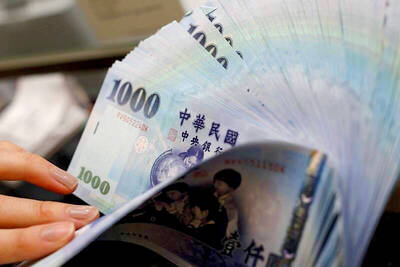The European Union will raise concerns with the US over a decision to restrict the export of artificial intelligence (AI) chips from the likes of Nvidia Corp to some of its member states, according to people familiar with the matter.
In one of its last moves in office, former US president Joe Biden’s administration introduced a three-tier system to curb sales of AI chips used in data centers. The US placed Poland and a number of its allies in the EU’s east in the second-tier category of countries that face limits to the amount of computing power they can purchase.
The goal of the measures, which companies such as Nvidia and Oracle Corp have warned could be catastrophic for the US tech industry, is to ensure that the global development of AI aligns with American standards and relies on US technology.

Photo: Ronald Wittek, EPA-EFE
The rules split the globe into a group of close US allies including western European nations as well as Canada, Japan and the UK, which won’t face serious restrictions. The second category that will involve caps on AI chip imports covers most of the world, while the third group involves adversaries such as China and Russia, which are effectively barred from buying the powerful semiconductors.
The move goes against the EU’s single market by treating member states differently, said the people, who spoke on condition of anonymity to discuss private discussions. It would also hinder innovation in the bloc’s east and unfairly favor western European companies, one of the people said.
Polish Minister of Digital Affairs Krzysztof Gawkowski said the White House’s decision was “incomprehensible and is not based on any substantive reasons.” Foreign ministers from Latvia, Estonia and Lithuania said in a joint statement that it undermines “the development of our national AI eco-systems.”
Although US President Donald Trump made little specific mention of Europe in his inaugural address, he has repeatedly threatened tariffs and the bloc is bracing for the worst.
If attempts to engage with the new US administration on alternatives such as a common approach to China fail, the EU has already prepared lists of goods to target if Trump moves forward with tariffs.

Merida Industry Co (美利達) has seen signs of recovery in the US and European markets this year, as customers are gradually depleting their inventories, the bicycle maker told shareholders yesterday. Given robust growth in new orders at its Taiwanese factory, coupled with its subsidiaries’ improving performance, Merida said it remains confident about the bicycle market’s prospects and expects steady growth in its core business this year. CAUTION ON CHINA However, the company must handle the Chinese market with great caution, as sales of road bikes there have declined significantly, affecting its revenue and profitability, Merida said in a statement, adding that it would

MARKET LEADERSHIP: Investors are flocking to Nvidia, drawn by the company’s long-term fundamntals, dominant position in the AI sector, and pricing and margin power Two years after Nvidia Corp made history by becoming the first chipmaker to achieve a US$1 trillion market capitalization, an even more remarkable milestone is within its grasp: becoming the first company to reach US$4 trillion. After the emergence of China’s DeepSeek (深度求索) sent the stock plunging earlier this year and stoked concerns that outlays on artificial intelligence (AI) infrastructure were set to slow, Nvidia shares have rallied back to a record. The company’s biggest customers remain full steam ahead on spending, much of which is flowing to its computing systems. Microsoft Corp, Meta Platforms Inc, Amazon.com Inc and Alphabet Inc are

RISING: Strong exports, and life insurance companies’ efforts to manage currency risks indicates the NT dollar would eventually pass the 29 level, an expert said The New Taiwan dollar yesterday rallied to its strongest in three years amid inflows to the nation’s stock market and broad-based weakness in the US dollar. Exporter sales of the US currency and a repatriation of funds from local asset managers also played a role, said two traders, who asked not to be identified as they were not authorized to speak publicly. State-owned banks were seen buying the greenback yesterday, but only at a moderate scale, the traders said. The local currency gained 0.77 percent, outperforming almost all of its Asian peers, to close at NT$29.165 per US dollar in Taipei trading yesterday. The

The US overtaking China as Taiwan’s top export destination could boost industrial development and wage growth, given the US is a high-income economy, an economist said yesterday. However, Taiwan still needs to diversify its export markets due to the unpredictability of US President Donald Trump’s administration, said Chiou Jiunn-rong (邱俊榮), an economics professor at National Central University. Taiwan’s exports soared to a record US$51.74 billion last month, driven by strong demand for artificial intelligence (AI) products and continued orders, with information and communication technology (ICT) and audio/video products leading all sectors. The US reclaimed its position as Taiwan’s top export market, accounting for